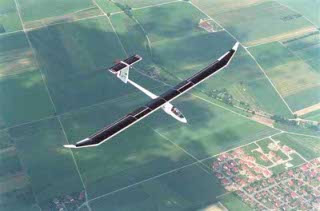 airplane Icare Credit: University of Stuttgart, Germany |
In 1955, the first solar-powered automobile was publicly demonstrated in Chicago. It was a 15-inch Sunmobile built by William G. Cobb of the General Motors Corporation. Light energy falling on 12 selenium photoelectric cells created electric current to power a tiny electric motor. The solar automobile was one of 253 free exhibits of the General Motors Powerama, Chicago, Illinois.
In 1976 NASA’s Lewis Research Center starts the installation of 83 PV power systems on every continent except Australia.
In 1978 was installed the world's first village PV system at Papago Indian Reservation, Schuchuli, Arizona.
In 1980 ARCO Solar is the first company to produce more than 1 MW of PV modules in one year.
In 1981 Paul MacCready builds the first PV-powered aircraft known as the Solar Challenger, which flies from France to England across the English Channel. The aircraft had over 16,000 solar cells mounted on its wings, which produced 3,000 watts of power.
Volkswagen began testing PV arrays mounted on the roofs of vehicles in 1982.
In 1982 a Danish-born Australian eco adventurer Hans Tholstrup drives the first solar-powered car - the Quiet Achiever - almost 2,800 miles between Sydney and Perth in 20 days. The vehicle had photovoltaic system of 1 kW and the average speed was 23 km/h. Tholstrup is the founder of the World Solar Challenge in Australia, considered the world championship of solar car racing.
In 1984, a 1 megawatt photovoltaic electricity plant began to operate in Sacramento, California.
ARCO Solar introduced a G-4000, the first commercial thin film photovoltaic module in 1986.
The world’s most advanced solar-powered airplane, the Icare, flew over Germany in 1996. The wings and tail surfaces of the Icare are covered by 3,000super-efficient solar cells, with a total area of 21 m2.
The 11th tallest skyscraper in New York City, built in the 1990s - the Condé Nast Building, officially 4 Times Square - includes building integrated photovoltaic (BIPV) panels on the 37th through the 43rd floors on the south and west-facing facades to produce a portion of the building’s power.
In 1999 Germany launches a 100,000 solar roofs scheme to promote the on-site generation of clean electricity.
On August 13, 2001 after long research and trial, the solar powered wing aircraft Helios set an unofficial world record by a winged aircraft of flying at a sustained altitude above 96,000 feet (29,250 m) for 40 minutes. Helios is a remotely operated (by two controllers using computers on the ground), solar powered aircraft developed by NASA and AeroVironment Inc.
In 2002 Japan installed 25,000 solar rooftops.
In 1976 NASA’s Lewis Research Center starts the installation of 83 PV power systems on every continent except Australia.
In 1978 was installed the world's first village PV system at Papago Indian Reservation, Schuchuli, Arizona.
In 1980 ARCO Solar is the first company to produce more than 1 MW of PV modules in one year.
In 1981 Paul MacCready builds the first PV-powered aircraft known as the Solar Challenger, which flies from France to England across the English Channel. The aircraft had over 16,000 solar cells mounted on its wings, which produced 3,000 watts of power.
Volkswagen began testing PV arrays mounted on the roofs of vehicles in 1982.
In 1982 a Danish-born Australian eco adventurer Hans Tholstrup drives the first solar-powered car - the Quiet Achiever - almost 2,800 miles between Sydney and Perth in 20 days. The vehicle had photovoltaic system of 1 kW and the average speed was 23 km/h. Tholstrup is the founder of the World Solar Challenge in Australia, considered the world championship of solar car racing.
In 1984, a 1 megawatt photovoltaic electricity plant began to operate in Sacramento, California.
ARCO Solar introduced a G-4000, the first commercial thin film photovoltaic module in 1986.
The world’s most advanced solar-powered airplane, the Icare, flew over Germany in 1996. The wings and tail surfaces of the Icare are covered by 3,000super-efficient solar cells, with a total area of 21 m2.
The 11th tallest skyscraper in New York City, built in the 1990s - the Condé Nast Building, officially 4 Times Square - includes building integrated photovoltaic (BIPV) panels on the 37th through the 43rd floors on the south and west-facing facades to produce a portion of the building’s power.
In 1999 Germany launches a 100,000 solar roofs scheme to promote the on-site generation of clean electricity.
On August 13, 2001 after long research and trial, the solar powered wing aircraft Helios set an unofficial world record by a winged aircraft of flying at a sustained altitude above 96,000 feet (29,250 m) for 40 minutes. Helios is a remotely operated (by two controllers using computers on the ground), solar powered aircraft developed by NASA and AeroVironment Inc.
In 2002 Japan installed 25,000 solar rooftops.



0 comments:
Post a Comment